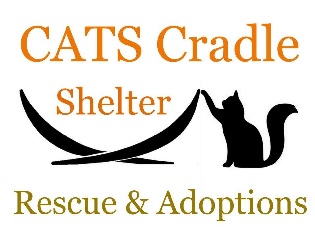Please read our information on fostering below and if you are interested in becoming a foster home, fill out a Foster Home Application.
Foster homes can be a vital part of a shelter’s “master plan” for saving animals. At Cats Cradle, we take great pride in our foster home program: Thanks to caring individuals and families (like you and yours), who step up when kitten homes are needed or when the shelters are full, Cats Cradle and the other local rescues have been able to save almost every adoptable cat from Fargo, Moorhead, and West Fargo since 2012 (we lost 2 in July 2012 due to lack of room). This is an amazing feat, considering that in the five years prior to 2012, between 430 and 700 cats were euthanized each year. Choosing to become a foster home means you have joined an amazing group of people who are truly changing the world for local cats and kittens.
Cats Cradle utilizes foster homes for many reasons including:
- Kitten foster care
- Caring for litters with moms
- Socializing older litters without moms
- Raising young orphans/bottle babies
- Emotional support foster care
- Supporting cats/kittens who need to decompress from stressful situations (for example, after a guardian has passed away)
- Helping extremely shy cats who need a lot of one-on-one time and attention as they learn to trust new people
- Caring for cats who find shelter living stressful.
- Medical foster care
- Providing quarantine overflow
- Supervising/monitoring weight management
- Monitoring/medicating cats recovering from illness
- Nursing cats recovering from surgery or trauma
- Short term respite or emergency fostering
- Respite fostering when a regular foster home goes on vacation or is otherwise unavailable
- Fostering on short notice for a few hours or a few days until we can find a long-term foster for the cat or kitten(s). Sometimes, we just need a place for new arrivals to go until we can work our way down the regular foster roster and get a hold of the right family for the situation!
Each type of fostering has its own requirements and skill set, but some things are universal. The universal requirements are:
- Foster cats should be kept in their own room, away from household cats. This is a conservative precaution that CCS encourages foster homes to respect.
Reasoning:
-
- Cats can carry serious diseases there is no test for (like Feline Infectious Peritonitis) or they may have been exposed to Feline Leukemia or Feline Immunodeficiency Virus so recently that they haven’t developed enough antibodies to trigger a positive test result during our intake process. Many of these disease are contagious between cats to one degree or another.
- Cats will frequently show minimal symptoms of less severe illnesses like eye, ear, or respiratory infections until the situation is fairly advanced. Bacterial, viral, and fungal illnesses are contagious to household pets.
- Cats who are shy, elderly, or recovering from illness/injury can find interacting with strange, new cats stressful and that may provoke setbacks in their progress.
- Young kittens do not have mature immune systems. Household pets may carry trace amounts of infectious agents that wouldn’t faze an adult cat, but which can endanger or kill a vulnerable kitten.
- If you choose to allow your personal cats to interact with foster cats, you assume all liability for injuries, illnesses, etc that may occur. If you are going to allow contact between foster cats and personal cats, speak with your veterinarian about vaccination protocols (they may recommend an FELV vaccination for your personal companions) and other precautions they may suggest.
- Foster homes will provide a safe, cat-proofed environment & adequate food, water, and social time for their foster cats. The foster cat(s) immediate environment should be kept relatively clean (we know food gets spilled and litter gets kicked around, but it should be picked up regularly). Cats like routines, so keeping to a schedule for feeding and play times cat reduce stress and help cats adapt to new environments.
- Foster homes will protect the foster cats in their care. Do not allow anyone in the household or visitors to scare or intimidate the foster cat (even if they think they are being funny), physically mistreat the foster cat, or engage in overly rough play.
- Foster homes will bring the foster cat/kittens to Cats Cradle for adoption hours. Kittens start coming to adoption hours after they are 8 weeks old and have had their first distemper shot. Prior to that time, too much handling and exposure to novel germs can stress kittens and make them sick. Older cats and those recovering from surgery should be brought when they are ready…which will be determined by conversations between the foster home and Cats Cradle staff. The timing will vary, depending upon the situation.
- Foster homes will bring the foster cat/kitten back to live at the shelter when the cat/kitten is ready. Again, the timing on this may vary and will be determined in conversations between the foster home and Cats Cradle. Cats Cradle will have the final word on when a foster cat will return to the shelter or be transferred to a different foster home.
Cats Cradle provides all the food, litter, and medical care for foster cats. We also loan out necessary equipment like a carrier, blankets, bowls, litter box/scoop, and toys if needed. We ask that the equipment be returned when the cat/kittens are adopted or join a shelter colony so we can sanitize it and use it for the next foster home.
Our Foster Home Coordinator works very hard to match the needs of each cat or litter with the skills/experience of the foster homes. We will never require a foster family to take on responsibilities outside their comfort level although many of our foster home get excited to take on new challenges as their confidence grows.


One thought on “Fostering a shelter cat”
Comments are closed.